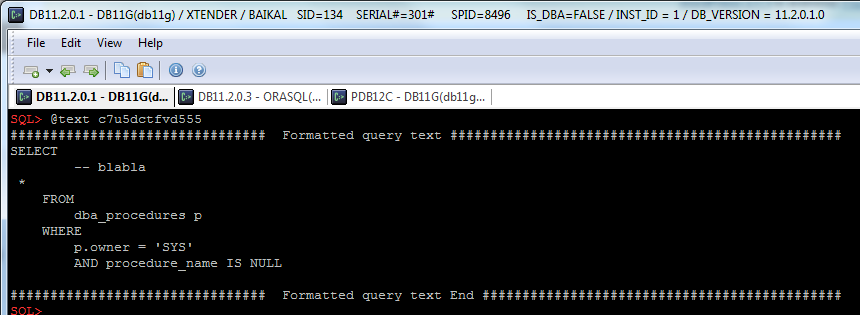Everyone knows Tom Kyte’s mantra:
You should do it in a single SQL statement if at all possible.
But we all know that “Every rule has an exception”
There are many different cases when pl/sql with sql can be more efficient than only sql, and i dont want to catalog them. I just want to show a couple examples of such exceptions:
1. Running totals by several dimensions
Simple example from forum:
select dt,
dim1,
dim2,
val,
sum(val) over(partition by dim1 order by dt) dim1_cumulative_sum,
sum(val) over(partition by dim2 order by dt) dim2_cumulative_sum,
sum(val) over(partition by dim1, dim2 order by dt) dim1_dim2_cumulative_sum
from mg_t
order by dt;
This query will be very hard for big data sets, so we can do it efficiently with pl/sql:
create or replace function xf_to_drop return xt2_to_drop pipelined
is
type tt is table of number index by pls_integer;
type tt2 is table of tt index by pls_integer;
dim1_c tt;
dim2_c tt;
dim12_c tt2;
begin
for r in (
select dt,
dim1,
dim2,
val
from mg_t
order by dt
)
loop
dim1_c(r.dim1):=case when dim1_c.exists(r.dim1) then dim1_c(r.dim1) else 0 end + r.val;
dim2_c(r.dim1):=case when dim2_c.exists(r.dim1) then dim2_c(r.dim1) else 0 end + r.val;
dim12_c(r.dim1)(r.dim2):=case
when dim12_c.exists(r.dim1)
and dim12_c(r.dim1).exists(r.dim2)
then dim12_c(r.dim1)(r.dim2)
else 0
end + r.val;
pipe row (xt1_to_drop( r.dt
,r.dim1
,r.dim2
,r.val
,dim1_c(r.dim1)
,dim1_c(r.dim1)
,dim12_c(r.dim1)(r.dim2)
));
end loop;
end;
/
[sourcecode language=”sql”]
create table mg_t as
select trunc(sysdate) + level/1440 dt,
trunc(3 * dbms_random.value()) dim1,
trunc(3 * dbms_random.value()) dim2,
trunc(100 * dbms_random.value()) val
from dual
connect by level <= 3e6;
create type xt1_to_drop is object(
dt date
,dim1 number
,dim2 number
,val number
,dim1_cumulative_sum number
,dim2_cumulative_sum number
,dim1_dim2_cumulative_sum number
);
create type xt2_to_drop as table of xt1_to_drop;
create or replace function xf_to_drop return xt2_to_drop pipelined
is
type tt is table of number index by pls_integer;
type tt2 is table of tt index by pls_integer;
dim1_c tt;
dim2_c tt;
dim12_c tt2;
begin
for r in (
select dt,
dim1,
dim2,
val
from mg_t
order by dt
)
loop
dim1_c(r.dim1):=case when dim1_c.exists(r.dim1) then dim1_c(r.dim1) else 0 end + r.val;
dim2_c(r.dim1):=case when dim2_c.exists(r.dim1) then dim2_c(r.dim1) else 0 end + r.val;
dim12_c(r.dim1)(r.dim2):=case
when dim12_c.exists(r.dim1)
and dim12_c(r.dim1).exists(r.dim2)
then dim12_c(r.dim1)(r.dim2)
else 0
end + r.val;
pipe row (xt1_to_drop( r.dt,r.dim1,r.dim2,r.val,dim1_c(r.dim1),dim1_c(r.dim1),dim12_c(r.dim1)(r.dim2)));
end loop;
end;
/
exec for r in (select * from table(xf_to_drop)) loop null; end loop;
[/sourcecode]
2. Finding connected components
Assume that we have big table with many-to-many relationship:
create table test (clientid NUMBER(10), accountid NUMBER(10));
How we can find all connected groups?
This example also taken from our russian forum and there was very good and simple sql-only solution, but it’s not efficient on big data sets:
select min(group_member_id) as group_max_id, accountid, clientid
from (select clientid as group_member_id
, connect_by_root accountid as accountid
, connect_by_root clientid as clientid
from test
connect by nocycle decode(accountid, prior accountid, 1, 0)
+ decode(clientid, prior clientid, 1, 0)
= 1
) a
group by accountid, clientid
order by group_max_id, accountid
/
This pure SQL solution is for the cases when ClientId and AccountId are different entities. If they are the same entities in your case, you need to use UNION ALL:
select min(group_member_id) as group_max_id, accountid, clientid
from (select clientid as group_member_id
, connect_by_root accountid as accountid
, connect_by_root clientid as clientid
from test
connect by nocycle decode(accountid, prior accountid, 1, 0)
+ decode(clientid, prior clientid, 1, 0)
= 1
) a
group by accountid, clientid
order by group_max_id, accountid
/
select min(group_member_id) as group_max_id, accountid, clientid
from (select clientid as group_member_id
, connect_by_root accountid as accountid
, connect_by_root clientid as clientid
from (select accountid, clientid from test union all select clientid,accountid from test)
connect by nocycle decode(accountid, prior accountid, 1, 0)
+ decode(clientid, prior clientid, 1, 0)
= 1
) a
group by accountid, clientid
order by group_max_id, accountid
/
We can try to remember algorithms courses and adopt one of the several algorithms for connected components:
[sourcecode language=”sql”]
declare
type int_array is table of pls_integer index by pls_integer;
type arr_elems is table of sys.ku$_objnumset index by pls_integer;
root int_array;
root_elems arr_elems;
n int;
clients int_array;
accounts int_array;
l integer:=dbms_utility.get_time();
procedure print(v in varchar2) is
begin
dbms_output.put_line(to_char((dbms_utility.get_time-l)/100,’0999.99′)||’ ‘||v);
l:=dbms_utility.get_time();
end;
function get_root(n int) return pls_integer is
begin
if root.exists(n) then
return root(n);
else
return null;
end if;
end;
procedure update_root(old_root pls_integer,new_root pls_integer) is
i pls_integer;
elem pls_integer;
cnt_old pls_integer;
cnt_new pls_integer;
begin
if old_root!=new_root then
–root_elems(new_root):=root_elems(new_root) multiset union all root_elems(old_root);
cnt_old:=root_elems(old_root).count;
cnt_new:=root_elems(new_root).count;
root_elems(new_root).extend(cnt_old);
for i in 1..cnt_old
loop
elem := root_elems(old_root)(i);
root(elem):=new_root;
root_elems(new_root)(cnt_new+i):=elem;
end loop;
root_elems(old_root).delete;
end if;
end;
procedure add_elem(p_root pls_integer, p_elem pls_integer) is
begin
if not root_elems.exists(p_root) then
root_elems(p_root):=sys.ku$_objnumset(p_elem);
else
root_elems(p_root).extend();
root_elems(p_root)(root_elems(p_root).count):=p_elem;
end if;
end;
procedure add_link(clientid pls_integer,accountid pls_integer) is
r1 pls_integer;
r2 pls_integer;
new_root pls_integer;
begin
r1:=get_root(clientid);
r2:=get_root(accountid);
if r1 is null or r2 is null then
new_root := coalesce(r1,r2,clientid);
if r1 is null then add_elem(new_root,clientid ); root(clientid) :=new_root; end if;
if r2 is null then add_elem(new_root,accountid); root(accountid):=new_root; end if;
else
new_root := least(r1,r2);
root(clientid) :=new_root;
root(accountid):=new_root;
update_root(greatest(r1,r2),new_root);
end if;
end;
function str_format(p int) return varchar2 is
begin
return utl_lms.format_message(‘(%d, %d) = group #%d’
,clients(p)
,accounts(p)
,get_root(clients(p))
);
end;
begin
print(‘start’);
select clientid,accountid
bulk collect into clients,accounts
from test
— where rownum<=1000
;
print(‘fetched’);
n:=clients.count;
dbms_output.put_line(‘count=’||n);
for i in 1..n loop
add_link(clients(i),accounts(i));
end loop;
print(‘processed’);
—
/*
for i in 1..n loop
dbms_output.put_line(str_format(i));
end loop;
— */
end;
[/sourcecode]
We can also try even more interesting special algorithms for parallel processing: CONNECTED COMPONENTS ALGORITHMS
FOR MESH-CONNECTED PARALLEL COMPUTERS


